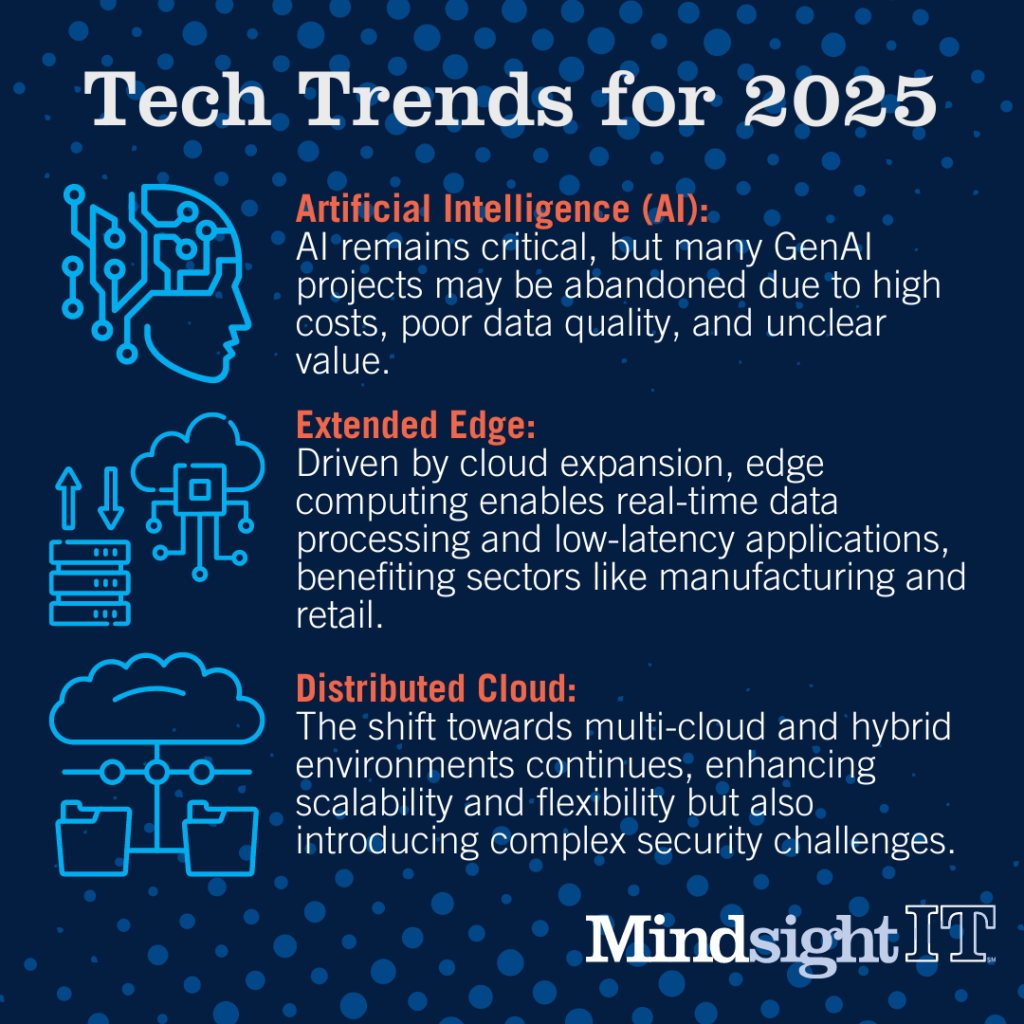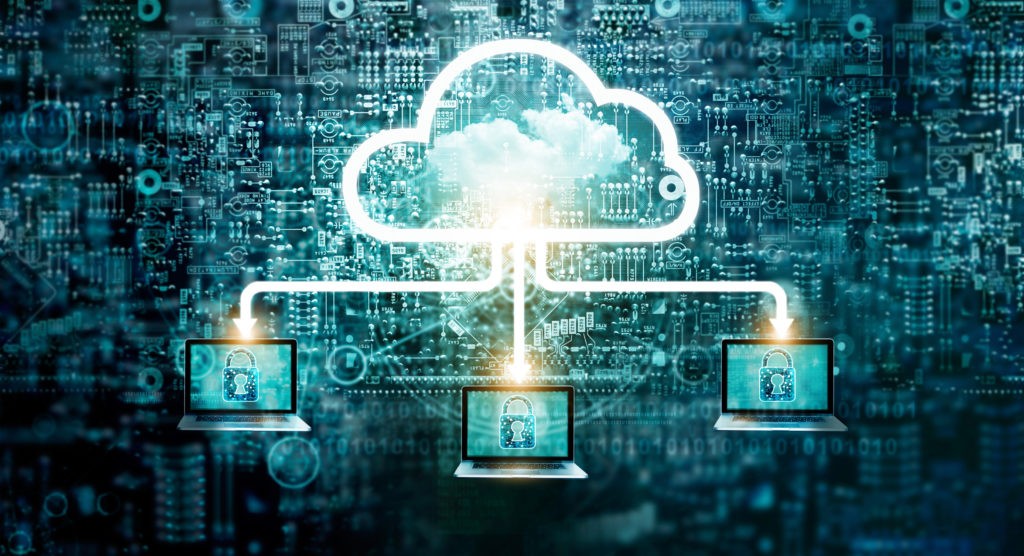August 29, 2024
As organizations plan their IT budgets for 2025, we thought it would be helpful to explore some key tech trends heading into next year. None are surprising, and not all of them apply to every business, but they’re still important to keep in mind when making spending decisions that will impact operations and customers.
Artificial Intelligence
Shocker, right? But there’s a good reason for AI’s ubiquity: its impact on everything from business automation and customer experience to healthcare advances and data analysis can’t (and shouldn’t) be underestimated. Then again, according to recent reports from Gartner, “At least 30% of generative AI (GenAI) projects will be abandoned after proof of concept by the end of 2025, due to poor data quality, inadequate risk controls, escalating costs or unclear business value.”
That’s straight from Rita Sallam, Distinguished VP Analyst at Gartner. “After last year’s hype, executives are impatient to see returns on GenAI investments, yet organizations are struggling to prove and realize value,” she told attendees at the Gartner Data & Analytics Summit in Sydney this past July. “As the scope of initiatives widen, the financial burden of developing and deploying GenAI models is increasingly felt.”
The Gartner report adds: “A major challenge for organizations arises in justifying the substantial investment in GenAI for productivity enhancement, which can be difficult to directly translate into financial benefit. Many organizations are leveraging GenAI to transform their business models and create new business opportunities. However, these deployment approaches come with significant costs, ranging from $5 million to $20 million.
But as with any technology, Sallam noted, there’s no such thing as one size fits all. “Whether you’re a market disruptor and want to infuse AI everywhere, or you have a more conservative focus on productivity gains or extending existing processes,” she said, “each has different levels of cost, risk, variability and strategic impact.”
Extended Edge
This has a lot to do with the ongoing expansion of cloud, which we’ll get to shortly. More cloud use is driving more demand for, as this write-up explains, “distributed devices and tools that can connect to a larger network. The “extended edge” is a data processing and storage solution that enables higher levels of functionality and processing at the edge of enterprise networks.”
According to a recent CNBC story, which quoted International Data Corporation numbers, global edge spending is expected to hit $232 billion this year (15% more than 2023) on its way to $350 billion by 2027. “In essence, edge computing complements cloud computing, extending digital transformation to the edge,” Thomas Bittman, a VP and analyst at Gartner, told the network. “It enables companies to capture more data and gain insights more quickly, augment physical interactions with digital information and controls, and puts intelligence where it needs to be.” (Sectors that can benefit most from edge computing include manufacturing, energy, retail, transportation, and defense.)
As summed up in the same report, Forrester Research principal Michele Pelino added that applications of edge—in autonomous vehicles or real-time predictive analytics, for example—”require low latency and real-time analytics enabled by edge computing. Data can be processed locally before going to the cloud for additional analysis using artificial intelligence.” Said Bittman, “Whenever an enterprise has people or assets widely distributed, where interactions are taking place at the edge — shopping, assembling, collaborating, systems of all sorts — edge computing may make sense.”

Distributed Cloud
We’re talking infrastructure, software and platform. It’s all increasingly cloud-based, and that won’t change as the years tick on. A massive uptick in cloud-native applications is and will continue to be part of that growth. As this post explains, cloud’s many benefits include simplified IT infrastructure management, scalability, cost effectiveness, flexibility, disaster recovery, comprehensive security and compliance, advanced devops and simple accessibility.
In addition to more adoption of multi- and hybrid cloud environments by organizations of all types and sizes, edge and AI will made the cloud experience even more powerful and effective. However, according to this Security Intelligence article, “Navigating cloud security is complex. As organizations enhance their cloud maturity, they inevitably encounter new challenges. Increased use of cloud services leads to the discovery of novel issues, perpetuating a cycle of continuous adaptation and problem-solving in the cloud domain.”
A recent blog post from Aspire Systems rightly encapsulated the correct approach to cloud for next year and beyond: “By staying ahead of key trends—such as the rise of hybrid and multi-cloud strategies, the growth of serverless computing, and the integration of AI and ML—businesses can ensure that their cloud strategies are forward-thinking and well-positioned for success. As we move into 2025, embracing the cloud-native future will be crucial for driving innovation and achieving sustainable growth in the digital era.”
About Mindsight
Headquartered in the Chicago suburb of Downers Grove, Mindsight offers fully managed IT services for organizations in a variety of industries. From cybersecurity to cloud, infrastructure to unified communications, our expert-only solution architects and engineers become an extension of your team, committed to your success. Located in Downers Grove, IL we proudly serve customers across the area including Naperville, Oak Brook, Northbrook, and surrounding counties (Cook, Lake, Dupage, Will, Kane, and Grundy). Our culture is built on transparency and trust, and our team is made up of extraordinary people – the kinds of people you would hire. We have one of the largest expert-level engineering teams delivering the full spectrum of IT services and solutions, from cloud to infrastructure, collaboration to contact center. Our highly certified engineers and process-oriented excellence have certainly been key to our success. But what really sets us apart is our straightforward and honest approach to every conversation, whether it is for an emerging business or global enterprise. Our customers rely on our thought leadership, responsiveness, and dedication to solving their toughest technology challenges.

